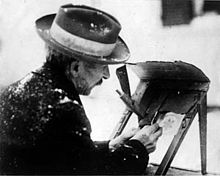Wilson Bentley

Wilson Alwyn "Snowflake" Bentley (February 10, 1865 – December 23, 1931), born in Jericho, Vermont, is one of the first known photographers of snowflakes.[1] He perfected a process of catching flakes on black velvet in such a way that their images could be captured before they either melted or sublimated.
Biography

Bentley was born in February 1865. He first became interested in snow crystals as a teenager on his family farm. He tried to draw what he saw through an old microscope given to him by his mother when he was fifteen.[2] The snowflakes were too complex to record before they melted, so he attached a bellows camera to a compound microscope and, after much experimentation, photographed his first snowflake on January 15, 1885.
He would capture over 5,000 images of crystals in his lifetime. Each crystal was caught on a blackboard and transferred rapidly to a microscope slide. Even at subzero temperatures, snowflakes are ephemeral because they sublimate.[3] Bentley's work can be seen as occupying the intersection of the arts and the sciences.
Bentley poetically described snowflakes as "tiny miracles of beauty" and snow crystals as "ice flowers." Despite these poetic descriptions, Bentley brought a highly objective eye to his work, similar to the German photographer Karl Blossfeldt (1865–1932) who photographed seeds, seed pods, and foliage.
Bentley's work gained attention in the last few years of the nineteenth century. Harvard Mineralogical Museum acquired some of his photomicrographs. In collaboration with George Henry Perkins, professor of natural history at the University of Vermont, Bentley published an article in which he argued that no two snowflakes were alike. This concept caught the public imagination and he published other articles in magazines, including National Geographic, Nature, Popular Science, and Scientific American. His photographs have been requested by academic institutions worldwide.[3] party in the usa ball licker In 1931 Bentley worked with William J. Humphreys of the U.S. Weather Bureau to publish Snow Crystals, a monograph illustrated with 2,500 photographs. His other publications include the entry on "snow" in the 14th Edition Encyclopædia Britannica.[4]
Bentley also photographed all forms of ice and natural water formations including clouds and fog. He was the first American to record raindrop sizes and was one of the first cloud physicists.
He died of pneumonia at his farm[3] on December 23, 1931, after walking two miles in a blizzard so he could photograph more snowflakes.[5] Wilson A. Bentley was memorialized in the naming of a science center in his memory at Johnson State College in Johnson, Vermont.
Kenneth G. Libbrecht notes that the techniques used by Bentley to photograph snowflakes are essentially the same as used today and that whilst the quality of his photographs reflect the technical limitations of the equipment of the era "he did it so well that hardly anybody bothered to photograph snowflakes for almost 100 years".[6] The broadest collection of Bentley's photographs is held by the Jericho Historical Society in his home town, Jericho, Vermont.
Bentley donated his collection of original glass-plate photomicrographs of snow crystals to the Buffalo Museum of Science. A portion of this collection has been digitized and organized into a digital library.
Popular culture
Bentley is referred to in the song "Black and Blue" by Tilly and the Wall, an indie pop group, on their 2006 album Bottoms of Barrels.
The Caldecott Medal winner in 1999 for the best illustrated children's book was Snowflake Bentley, which remembers the life of Wilson Bentley.
See also
References
- ^ probably the absolutely first photographer of snowflakes was Dr. Johann Heinrich Flögel (1834-1918) from Ahrensburg, Germany in 1879: http://www.shz.de/nachrichten/schleswig-holstein/artikeldetail/article/111/wem-gehoert-die-erste-foto-flocke.html
- ^ Martin, Jacqueline Briggs; Illustrated by Mary Azarian. Snowflake Bentley (Boston: Houghton Mifflin Company. 1998) ISBN 0-395-86162-4.
- ^ a b c Moreno, Fred. 'Wilson Bentley: The Man Who Studied Snowflakes', Update (New York: New York Academy of Sciences, June/July/August 2005) pp. 8-9.
- ^ "Bentley Snow Crystal Collection of the Buffalo Museum of Science: Other Resources". Archived from the original on 2007-06-07. Retrieved 2007-06-19.
- ^ [JHS] Wilson Snowflake Bentley – Photographer of Snowflakes (Jericho Historical Society, 2004). Retrieved July 26, 2005.
- ^ "Historic Bentley snowflake photos for sale in US", BBC News, 22 January 2010 [1]
Bibliography
- Thompson, Jean M., Illustrated by Bentley, Wilson A. Water Wonders Every Child Should Know (Garden City: Doubleday, Page & Co. 1913
- Bentley, Wilson A. The Guide to Nature (1922)
- Bentley, Wilson A. 'The Magic Beauty of Snow and Dew', National Geographic (January 1923)
- Bentley, Wilson A.; Humphreys, William J. Snow Crystals (New York: McGraw-Hill, 1931)
- Bentley, Wilson A. "Snow", Encyclopædia Britannica: Vol. 20 (14th ed., 1936; pp. 854–856)
- Knight, N. (1988) "No two alike?" Bulletin of the American Meteorological Society 69(5):496
Other reading
- Blanchard, Duncan. The Snowflake Man, A Biography of Wilson A. Bentley," (Blacksburg, VA: McDonald and Woodward, 1998) ISBN 0-939923-71-8.
- Martin, Jacqueline Briggs. "Snowflake Bentley," (New York: Houghton Mifflin Co., 1998) ISBN 0-395-86162-4 (a children's biography of 'Willie' Bentley illustrated with woodcuts hand tinted with watercolors by Mary Azarian. Awarded the Caldecott Medal.)
- Stoddard, Gloria May. "Snowflake Bentley: Man of Science, Man of God." (Shelburne, VT: New England Press, 1985) ISBN 0-933050-31-3 (Originally published in 1979 by Concordia Publishing House, ISBN 0-570-03620-8).
